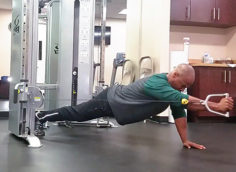This variation completely takes the non-working leg out of the equation, which gives it a host of "functional" benefits. To every meathead's delight, however, one study made a compelling case that the single-leg squat can be a powerful strength and muscle-builder, too (1).
Single-Leg Squat
The researchers challenged the assumption that the load taken on by the working leg during single-leg squats is half that of bilateral squats. To do so, they integrated a model based on segmental weight distributions (the load acting above or rotating about the hip joint) with force data to determine how much true load the legs take on in both unilateral and bilateral movements.
They discovered two things:
- The combined bodyweight that acts above the hips during unilateral movements is 16% greater than during bilateral movements (84% vs. 68%).
- Unilateral movements equate to 1.62x the intensity (per leg) of bilateral movements (in sum).
So, the single-leg squat places significantly more load on the working leg than standard squats do between both legs, which means they can be done with significantly lighter loads while achieving just as much of a loading effect – and then some – as standard squats.
To quantify the relative load comparisons, they came up with the following:
- One-leg squat with no external load > 1.0x BW back squat
- One-leg squat + 10% BW in external load = 1.5x BW back squat
- One-leg squat + 50% BW in external load = 2x BW back squat
- One-leg squat + 100% BW in external load = 3x BW back squat
As an example, I used 110-pounds of external load in weight vests and chains for 8 reps – about 50% of my body weight – which, according to the study, would equate to a 420-pound back squat for reps.
Then add the fact that single-leg squats involve constant tension and high intra-muscular activation, and you'll see that they can be a great option for building bigger legs and a stronger squat.
Reference
- Natera, Alex et al. "Load Comparison Ratio in Single and Double Leg Movements." English Institute of Sport, UK (2015).




